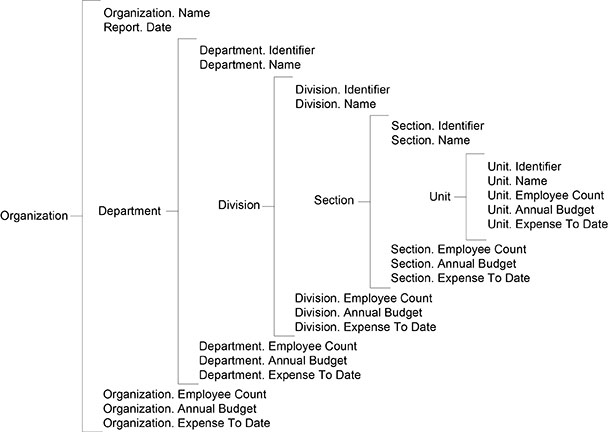Appendix B
DATA HIERARCHY NOTATION
The data on screens, reports, and forms are documented in a data hierarchy for better understanding and inventorying. The traditional data hierarchy, using set theory notation, is shown in Figure B.1. The data hierarchy represents a simple report for an organization showing departments, divisions, sections, and units within the organization. The nested data sets show a parent – subordinate relationship

Figure B.1. Data hierarchy using traditional notation.
The name of each data set in the hierarchy is shown on the left of the data set symbol and the contents of each data set are shown on the right. The contents at the top of the data set are identifying data items and the contents at the bottom of each data set are the summary data items.
The traditional data hierarchy notation can become quite wide and difficult to print on a single page. The data hierarchy notation can be adjusted to a narrower notation by moving the data set name to the top, right of the data set symbol, as shown in Figure B.2. The data hierarchy is identical to the data hierarchy shown in Figure B.1, except that it has a narrower and longer format.

Figure B.2. Data hierarchy using adjusted notation.
The choice of a data hierarchy notation is up to the organization, or to individuals in the organization who are developing the data hierarchy. The choice may depend on the tools available, the method of documentation, and how well people understand the data hierarchy. A consistent data hierarchy notation may be used throughout the organization, or both data hierarchy notations may be used.
The highest level in the data hierarchy represents the screen, report, or form. The organization name and date of the report are shown at the top of the data set. The nested data sets in the data hierarchy represent subordinate organizational units.
The data hierarchy shown in Figures B.1 and B.2 is commonly referred to as a fixed data hierarchy. The parent – subordinate relations are fixed and cannot change. For example, sections cannot belong to units, and departments cannot belong to sections.
The totals in a fixed data hierarchy are commonly referred to as summary data. For example, the totals for employee count, annual budget, and expense to date are accumulated from individual units, through sections, divisions, and departments, to a total for the organization. These summary data are named according to their place in the hierarchy, such as Unit. Employee Count, Section. Employee Count, Division. Employee Count, Department. Employee Count, and Organization. Employee Count.
The data hierarchies may show either the formal data names according to the data naming taxonomy, or common data names that may appear on the screen, report, or form. Some people prefer to see the formal data names so that they can relate the data to a common data architecture. Other people prefer to see the common data names. Either way is acceptable.
